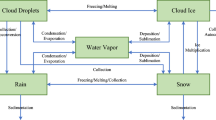Abstract
A sever thunderstorm is composed of strong convective clouds. In order to perform a simulation of this type of storms, a very fine-grid system is necessary to resolve individual convective clouds within a large domain. Since convective clouds are highly complicated systems of the cloud dynamics and microphysics, it is required to formulate detailed cloud physical processes as well as the fluid dynamics. A huge memory and large-scale parallel computing are necessary for the computation. For this type of computations, we have developed a cloud resolving numerical model which was named the Cloud Resolving Storm Simulator (CReSS). In this paper, we will describe the basic formulations and characteristics of CReSS in detail. We also show some results of numerical experiments of storms obtained by a large-scale parallel computation using CReSS.
Access this chapter
Tax calculation will be finalised at checkout
Purchases are for personal use only
Preview
Unable to display preview. Download preview PDF.
Similar content being viewed by others
References
Klemp, J. B., and R. B. Wilhelmson, 1978: The simulation of three-dimensional convective storm dynamics. J. Atmos. Sci., 35, 1070–1096.
Ikawa, M., 1988: Comparison of some schemes for nonhydrostatic models with orography. J. Meteor. Soc. Japan, 66, 753–776.
Ikawa, M. and K. Saito, 1991: Description of a nonhydrostatic model developed at the Forecast Research Department of the MRI. Technical Report of the MRI, 28, 238pp.
Xue, M., K. K. Droegemeier, V. Wong, A. Shapiro and K. Brewster, 1995: Advanced Regional Prediction System, Version 4.0. Center for Analysis and Prediction of Storms, University of Oklahoma, 380pp.
Grell, G., J. Dudhia and D. Stauffer, 1994: A description of the fifth-generation of the Penn State / NCAR mesoscale model (MM5). NCAR Technical Note, 138pp.
Orlanski, I., 1976: A simple boundary condition for unbounded hyperbolic flows. J. Comput. Phys., 21, 251–269.
Lin, Y. L., R.D. Farley and H.D. Orville, 1983: Bulk parameterization of the snow field in a cloud model. J. Climate Appl. Meteor., 22, 1065–1092.
Cotton, W. R., G. J. Tripoli, R. M. Rauber and E. A. Mulvihill, 1986: Numerical simulation of the effects of varying ice crystal nucleation rates and aggregation processes on orographic snowfall. J. Climate Appl. Meteor., 25, 1658–1680.
Murakami, M., 1990: Numerical modeling of dynamical and microphysical evolution of an isolated convective cloud — The 19 July 1981 CCOPE cloud. J. Meteor. Soc. Japan, 68, 107–128.
Murakami, M., T. L. Clark and W. D. Hall 1994: Numerical simulations of convective snow clouds over the Sea of Japan; Two-dimensional simulations of mixed layer development and convective snow cloud formation. J. Meteor. Soc. Japan, 72, 43–62.
Smagorinsky, J., 1963: General circulation experiments with the primitive equations. I. The basic experiment. Mon. Wea. Rev., 91, 99–164.
Louis, J. F., M. Tiedtke and J. F. Geleyn, 1981: A short history of the operational PBL parameterization at ECMWF. Workshop on Planetary Boundary Layer Parameterization 25–27 Nov. 1981, 59–79.
Klaassen, G. P. and W. R. Peltier, 1985: The evolution of finite amplitude Kelvin-Helmholtz billows in two spatial dimensions. J. Atmos. Sci., 42, 1321–1339.
Wilhelmson, R. B., and J. B. Klemp, 1978: A numerical study of storm splitting that leads to long-lived storms. J. Atmos. Sci., 35, 1974–1986.
Weisman, M. L., and J. B. Klemp, 1982: The dependence of numerically simulated convective storms on vertical wind shear and buoyancy. Mon. Wea. Rev., 110, 504–520.
Weisman, M. L., and J. B. Klemp, 1984: The structure and classification of numerically simulated convective storms in directionally varying wind shears. Mon. Wea. Rev., 112, 2478–2498.
Klemp, J. B., and R. Rotunno, 1983: A study of the tornadic region within a supercell thunderstorm. J. Atmos. Sci., 40, 359–377.
Wicker, L. J., and R. B. Wilhelmson, 1995: Simulation and analysis of tornado development and decay within a three-dimensional supercell thunderstorm. J. Atmos. Sci., 52, 2675–2703.
Grasso, L. D., and W. R. Cotton, 1995: Numerical simulation of a tornado vortex. J. Atmos. Sci., 52, 1192–1203.
Author information
Authors and Affiliations
Editor information
Editors and Affiliations
Rights and permissions
Copyright information
© 2002 Springer-Verlag Berlin Heidelberg
About this paper
Cite this paper
Tsuboki, K., Sakakibara, A. (2002). Large-Scale Parallel Computing of Cloud Resolving Storm Simulator. In: Zima, H.P., Joe, K., Sato, M., Seo, Y., Shimasaki, M. (eds) High Performance Computing. ISHPC 2002. Lecture Notes in Computer Science, vol 2327. Springer, Berlin, Heidelberg. https://doi.org/10.1007/3-540-47847-7_21
Download citation
DOI: https://doi.org/10.1007/3-540-47847-7_21
Published:
Publisher Name: Springer, Berlin, Heidelberg
Print ISBN: 978-3-540-43674-4
Online ISBN: 978-3-540-47847-8
eBook Packages: Springer Book Archive




